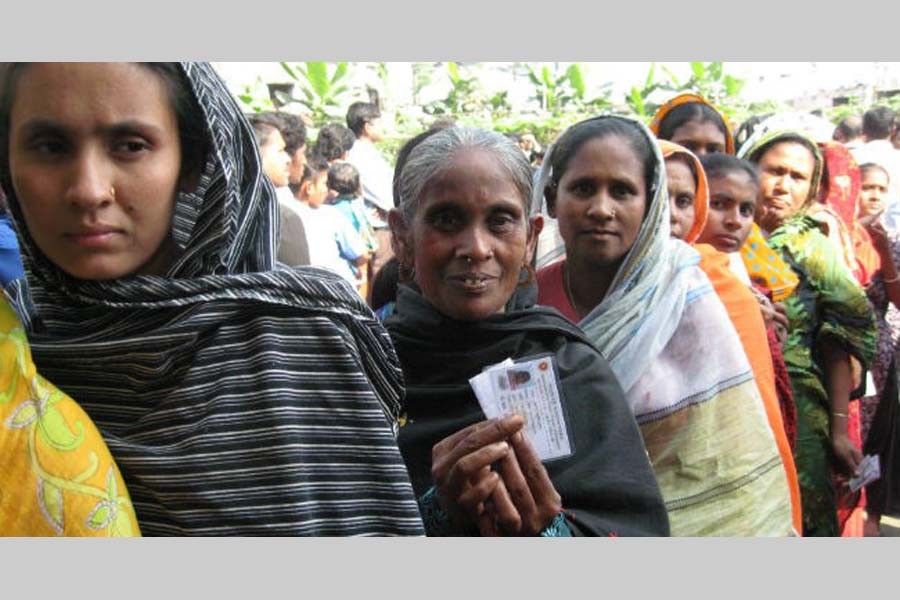
Published :
Updated :

Rural people possibly would participate in the national election in a relatively more joyous mood than ever, provided that they are free to choose their candidates without any fear. One of the reasons for the jubilation is the improvement of the overall socio-economic condition in rural areas. Particularly, income has increased by a respectable margin for both rich and poor during the last couple of years. Barring 2017, when consecutive floods adversely affected agricultural output, there has been a persistent rise in agricultural output, especially of rice. Besides, migration, growth of non-rice , non-agricultural products also contributed to the kitty.
Income is considered to be one of the most important determinants of livelihoods in a society. But it must also be admitted that ignoring distributional issues, the goal of increasing per-capita income alone does not ensure welfare for all. It is mainly because the level and the sources of household income are responsible for the existing differential livelihood system. However, estimation of such income, especially in rural areas, is always very complex and hard task and the reasons are not far to seek. There is hardly any record keeping system for inputs purchased and output produced in the vast spectrum of informal transactions in rural areas. The respondents attempt to answer most of the income-related questions from memory. Again, advertently or inadvertently, the general tendency to under-report income makes it a more difficult job to arrive at a correct estimate. Besides, sometimes the "guess-based" accounts of income given by respondents cannot be cross-checked due to a lack of alternative information. On the other hand, the most difficult problem arises when households' own production is never considered an income for a household. The same happens with the in-kind income that households receive. And only for these reasons, estimates of rural income remain noisy and especially, the balance is tilted towards undervaluation.
In the estimation of household income as used in this write-up, we have adopted a different technique to minimise errors and omissions. For example, (a) receipts in kind or in cash, have been treated as income. In this case, money value was imputed to in-kind earnings, and the value represents the prevailing prices in survey areas; (b) households' self-produced products and by-products, such as crop, livestock and poultry, fisheries and forest products were bracketed as income on the assumption that expenditure saved is also income earned and, (c) the income from crops has been estimated by the value of the main product and by-product. The value of inputs used has been deducted to arrive at net income of the household. The prices of the inputs supplied by a household were imputed at the prevailing prices in the market.
As a panel data of rural households spanning 1988-2014 show, per-capita income of rural household has gone up respectfully implying a growth rate of about 3.0 per cent per annum over the last few decades. During 2010-2014, it has been roughly 5.0 per cent per annum. Admittedly, a decline in household size over the comparable period fuelled much of the growth rate in per capita income. We observe that about half of the total income originates from agriculture; the share was about 60 per cent decades back. This indicates that the income from agriculture has fallen in the comparable periods. Quite apparently, the fall in agriculture's share has mainly been caused by drastic reduction in income from paddy farming. But incomes from non-paddy and non-crop agriculture have increased at respectable rates overtime.
The source of income that witnessed substantial decline overtime is wage labour in agriculture It is the labour that mainly the poor in rural areas exchange for livelihoods. We observe that the contribution of this source to household income has almost halved over the comparable periods. The reason may be that the poverty-stricken labour force is leaving for more remunerative engagements in non-farm sector. Or, may be, agricultural labour of the distant past has started own cultivation by accessing the tenancy market that has witnessed a robust growth in the last couple of years. Also the forms of tenancy have moved away from exploitative and inefficient share-cropping system. By and large, it can be said that rural households are much less dependent on paddy farming and agricultural wage income for a living.
A lion's share of the total household income (roughly 60 per cent) originates from the non-agricultural activities. We can argue that a robust rate of growth (over 5.0 per cent a year) swept the sector overtime. Again, among the non-agricultural sources, remittances emerged as a promising source of household income along with business/trade and services. Needless to mention that expansion of rural infrastructure, increase in labour demand abroad, a liberalised commercial regime and increasing roles of the private sector in production and marketing of inputs and outputs facilitated the increased participation of rural people in these activities.
The festive election mood among rural people also owes much to the expansion of digital technology and television network spreading fast in the last couple of years along with expansive coverage of safety net programmes. Finally, the drastic drop in poverty rate seemingly made the mood livelier. Now the onus lies on the EC and the government to ensure that the festive mood sustains.
Abdul Bayes is a former Professor of Economics at Jahangirnagar


 For all latest news, follow The Financial Express Google News channel.
For all latest news, follow The Financial Express Google News channel.